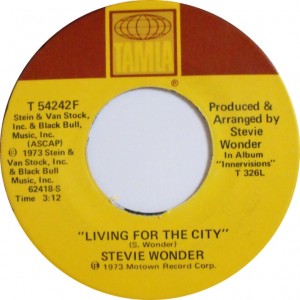
 The celebrated career of Stevie Wonder is far too extensive to recap here. Instead I’m going to focus on just one of his many great albums, and in particular one song from that album. Today we go back to 1973 and Stevie’s album Innervisions. The album featured classics like “Don’t You Worry ’bout a Thing,” “Golden Lady,” and “Higher Ground,” but it’s a stunning cry for social justice that is the featured track this week.
The celebrated career of Stevie Wonder is far too extensive to recap here. Instead I’m going to focus on just one of his many great albums, and in particular one song from that album. Today we go back to 1973 and Stevie’s album Innervisions. The album featured classics like “Don’t You Worry ’bout a Thing,” “Golden Lady,” and “Higher Ground,” but it’s a stunning cry for social justice that is the featured track this week.
Innervisions was Stevie’s 16th album. His career began when he signed with Motown’s Tamla imprint when he was only 11 years-old. By the time he was 13 “Little” Stevie Wonder had a major hit with “Fingertips (Pt. 2),” which was taken from a live recording of a Motor Town Revue show.
It wasn’t long before the “Little” was dropped, and Stevie roared through the ’60s with smash hits like “Uptight (Everything’s Alright),” “For Once In My Life,” “I Was Made To Love Her,” and “Signed, Sealed, Delivered I’m Yours.” Even with massive success behind him, mega-stardom still lay ahead.
Stevie’s classic era began when he allowed his Motown contract to expire in 1971, when he was just 21 years-old. The idea was not to leave Motown, but to put pressure on the label to get them to agree to his demands for complete creative control. Eventually Motown acquiesced, giving Stevie not only the creative control that he sought, but a higher royalty rate, and the rights to his own songs. It was unprecedented.
Stevie responded with his first complete artistic statement when he released Music of My Mind in 1972. Later that same year he stunned the world with his follow up, Talking Book, which spawned the #1 singles “Superstition,” and “You Are the Sunshine of My Life.” The two songs won Stevie three Grammys that year.
In case there was any question about whether Stevie could continue on his amazing roll, he followed Talking Book with Innervisions in 1973. Just like the other albums of his golden period, Stevie was responsible for nearly all of the songs and production, and he played most of the instruments. Innervisions featured the ARP synthesizer extensively as Stevie continued to blaze new trails technologically. The album was hugely influential on the music that would follow.
“Living For the City” tells the story of a young man being raised in “hard time Mississippi.” There he faces the issues of poverty and racism. As his frustration grows so too does the tension in Stevie’s voice. Finally the young man heads to New York City looking for opportunity. There someone tricks him into carrying drugs. He is arrested and sentenced to 10 years in prison. As the anger boils over Stevie’s voice becomes an almost indecipherable growl. It was an effect that Stevie’s co-producers worked hard to get, continually inciting Stevie during the recording of the song’s last verse. The result is a truly stunning representation of the lyrics.
“Living For the City” reached #8 on the Billboard Pop Singles chart, and #1 on the Billboard Black Singles chart. The album version, featured here, clocks in at 7:21, and the single edit at 3:41. The Innervisions album was the #1 Pop album of the year in Cashbox, and #4 in Billboard. It is widely considered Stevie’s finest moment, and one of the greatest albums of all time.
[youtube id=”QnbdXWvmysg” width=”600″ height=”350″]





Comments